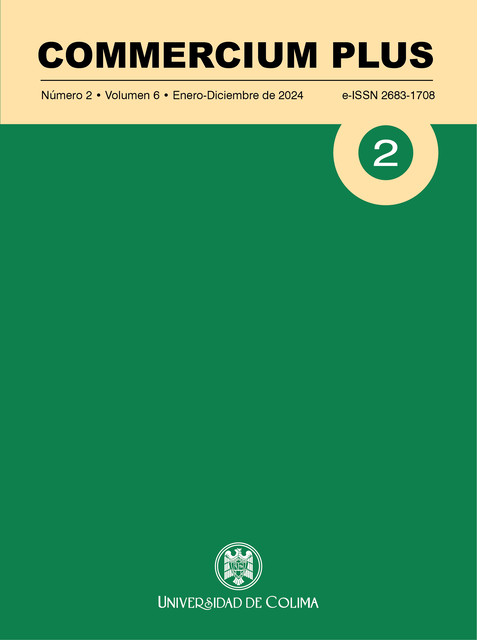Evolution of banking infrastructure and its impact on the traditional branch model.
DOI:
https://doi.org/10.53897/RevCommerP.2024.06.06Keywords:
banking infrastructure, innovation, bankingAbstract
In recent years, the adoption of Information Technologies (ICTs) has modified the relationship between users and companies. Understanding the new times, banks modified their infrastructure to the user’s needs by making available access points far from the branch. In the last decade, the sector has grown
significantly in its digital infrastructure, but not in the branches. This research analyses whether the increase in Automated Teller Machines (ATM), Point of Sale Terminals (POS), Mobile Banking (BM), and Commission Businesses
(MNC) has an impact on the number of branches. The objective is to have empirical evidence that supports the change in the business model that has the traditional branch as its axis to the adoption of alternative access points supported by digitalization. With information from the National Banking and
Securities Commission of the major seven banks and using the panel data methodology, evidence of the significant relationships proposed is obtained. Among the main findings is that MNC and ATM have a direct relationship with the number of branches. In contrast, TPV and BM have an inverse relationship, which means that as this infrastructure increases, the number of branches decreases.
Downloads
Metrics
References
Amin, A., Arefin, S., Sultana, N., Islam, R., Jahan, I., & Akhtar, A. (2020). Evaluating the customers’ dining attitudes, e-satisfaction and continuance intention toward mobile food ording apps (MFOAs): evidence from Bangladesh. European Journal of Management and Business Economics, 30(2), 211–229. https://doi.org/10.1108/EJMBE-04-2020-0066
Angel, G. Del. (2019). Banco Nacional de México y la innovación en los servicios bancarios. Publicaciones Internacionales.
BBVA. (2023). Resumen para Inversionistas, GFBB 2023. https://investors.bbva.mx/es/
Carter Hill, R., Griffiths, W., & Lim, G. (2011). Principles of Econometrics. CNBV. (2024). BE_BM_202311.
Dzombo, G. K., Kilika, J. M., & Maingi, J. (2017). The Effect of Branchless Banking Strategy on the Financial Performance of Commercial Banks in Kenya. International Journal of Financial Research, 8(4), 167. https://doi.org/10.5430/ijfr.v8n4p167
Gichungu, Z. N., & Oloko, M. A. (2015). Relationship between Bank Innovations and Financial Performance of Commercial Banks in Kenya. In International Journal of Education and Research (Vol. 3, Issue 5). www.ijern.com
Ky, S. S., Rugemintwari, C., & Sauviat, A. (2021). Friends or Foes? Mobile money interaction with formal and informal finance. Telecommunications Policy, 45(1). https://doi.org/10.1016/j.telpol.2020.102057
Magallón-González, H. B., Galeana-Figueroa, E., & Prado-Román, C. (2022). Banking innovations and their effect on profitability. Mercados y Negocios, 23(47), 25–56. https://doi.org/10.32870/myn.vi47.7680
Magallón, H., Galeana, E., & De la Torre, O. (2023). The Effect of Banking Channels and Efficiency Indicators on. Mercados y Negocios, 24(48), 3–26. https://doi.org/10.32870/myn.vi48.7685
Marshall, J. N., & Richardson, R. (1996). The impact of “telemediated” services on corporate structures: The example of “branchless” retail banking in Britain. Environment and Planning A, 28(10), 1843–1858. https://doi.org/10.1068/a281843
Nubank. (2024). Nubank. Sobre Nu. https://international.nubank.com.br/es/sobre-nu/
Palaon, H., Wiryono, S. K., & Faturohman, T. (2020). Branchless banking agents: Business satisfaction, continuity, and viability. Cogent Business and Management, 7(1). https://doi.org/10.1080/23311975.2020.1823585
Rita, P., Ramos, R. F., Moro, S., Mealha, M., & Radu, L. (2021). Online dating apps as a marketing channel: a generational approach. European Journal of Management and Business Economics, 30(1), 1–17. https://doi.org/10.1108/EJMBE-10-2019-0192
Smith, M. K., & Coronel, M. (2023). Technology Acceptance and Readiness among different Generations of Urban Touists. Marketing & Menedzsment, 57(1), 37–48. https://doi.org/10.15170/mm.2023.57.01.04
Villegas, E., & Ortega, R. M. (2002). Sistema Financiero de México.
Zhu, Q., Lyu, Z., Long, Y., & Wachenheim, C. J. (2021). Adoption of mobile banking in rural China: Impact of information dissemination channel. Socio-Economic Planning Sciences, November 2020, 1–9. https://doi.org/10.1016/j.seps.2021.101011
Downloads
Published
How to Cite
Issue
Section
License
Copyright (c) 2024 COMMERCIUM PLUS

This work is licensed under a Creative Commons Attribution-NonCommercial-ShareAlike 4.0 International License.
COMMERCIUM PLUS permite compartir, copiar y redistribuir el material en cualquier medio o formato; adaptar, remezclar, transformar y construir sobre el material, dando crédito a la obra de manera adecuada y proporcionando un enlace a la licencia, indicando si se han realizado cambios.







